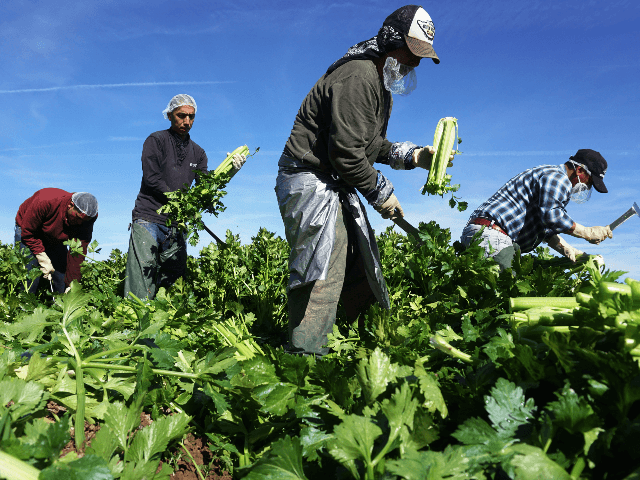Agriculture department officials have announced they will not conduct a routine annual survey on wages in the farm sector, likely helping agriculture employers to suppress wages for the expected supply of 230,000 H-2A workers in 2021.
The decision by former Gov. Sonny Perdue’s Department of Agriculture was slammed by the left and the right as bad for Americans and for the H-2A migrant workers.
“This seems like an ill-advised move during such difficult economic times, and far too many U.S. workers have had to endure pay cuts and job losses,” said Jessica Vaughan, policy director at the Center for Immigration Studies. She continued:
Sadly, it’s not a surprise, as Trump’s agriculture officials are practically lobbyists for the farm employers, always looking to implement policies that lower the cost of farm labor, especially by keeping the pipeline of farm visa workers as large as possible. It’s not going to serve the President very well in this hotly contested election.
“This action will have the consequence of lowering [American] farmworker wages,” said Giev Kashkooli, the political & legislative director at the United Farm Workers union. He continued:
The current law allows [agriculture employers] to bring in an unlimited number of people on the H-2A [visa] program. The protection for U.S. … workers is that the employer is required to pay [the foreign] workers in the H-2A program the average wage that farmworkers in the United States are receiving by region. So that term, “Adverse Effect Wage Rate” really should just be called the average wage. But it’s called “adverse effect” because its purpose is to not have an adverse effect on U.S. citizens and legal permanent residents.
So that’s what the compromise was under President [Ronald] Reagan and has existed till now: ‘You can bring in as many [H-2A] people as you want, as long as you’re paying people the [AEWR] average wage.’
In 2019, agriculture employers imported up to 230,000 H-2A workers and paid them at the various AEWR rates, which rose by an average of six percent and reached up to $15 per hour. That wage-level protected Americans from long jobs or wages to H-2A workers, and also pressured employers to invest in labor-saving, wage-boosting machinery.
But Perdue is blocking the AEWR survey for 2021 so that employers can pay the H-2A workers at rates set by the employers’ flawed surveys, Kashkooli argued. The wage rates will be skewed downward by the arrival of more H-2A workers, creating a cycle of shrinking wages and underpaid H-2A workers, he argued.
“The Trump administration is proposing that you can bring in as many people you want, but you can do it at minimum wage,” Kashkooli said.
The Agricultural Labor Survey is used to set the AEWR wage rates. It is conducted by the National Agricultural Statistics Service (NASS). A department statement said the “USDA has determined that the public can access other data sources for the data collected in the Agricultural Labor Survey.”
The department declined Breitbart’s request for information about how the AEWR wages can be set.
Agricultural employers say they are under intense economic pressure from each other and from increasingly sophisticated foreign suppliers. The foreign farms are using very cheap labor, plus improving technology, skilled managers, low-cost transportation, and free-trade deals to win larger shares of U.S. food sales.
The American Farm Bureau Federation is touting the department’s decision to drop the survey, according to Agri-pulse.com:
The Labor Department uses the NASS wage survey to set the annual state wage minimums, known as the Adverse Effect Wage Rate, or AEWR, for H-2A workers. This year, the rates went up 6% nationally, with farmers in some states seeing increases of up to 10%.
…
Veronica Nigh, an economist with the American Farm Bureau Federation, called the USDA move “a step in the right direction to ensure the wage setting mechanism for H-2A workers does not encompass flawed data that disproportionately penalizes farmers who rely on guest workers.”
She said, “Nothing in this announcement states an intent to lower wages for domestic and foreign workers.”
The left-wing and the right-wing activists jointly criticized the agriculture department — but they differ over the impact of imported labor.
“What is surprising is that the farmworker advocates have abandoned their historic support for tighter controls on farmworker visas,” said Vaughan:
If they put their energies into fighting against the mass importation of foreign farmworkers and against illegal immigration, they would help instigate movement toward a more modern farm industry that relies more heavily on mechanization and technology and creates better, higher-paying farm jobs.
Instead, they’ve chosen to embrace a never-ending labor surplus fueled by foreign labor that ensures that keeps their wages low and gives the employers the upper hand.
Congress has repeatedly approved — but not passed — bills that would dramatically raise the inflow of cheap labor into farmworker jobs.
Under Trump, the reduced inflow of legal refugees and illegal migrants have nudged up food-industry wages. In turn, the rising labor price prompted farm companies to invest in lab0r-saving, wealth-creating machinery for a wide range of delicate and skilled tasks, including meat processing, cow-milking, and fruit picking:

COMMENTS
Please let us know if you're having issues with commenting.